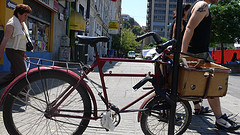
flic.kr/p/5Sm5nM
Utility cycling is a broad term used to pertain to cycling as a means of transportation. It is used to refer to students using cycles to go to schools, delivery boys using bicycles to deliver groceries, postmen using bicycles to deliver mail, or office-goers using bicycles to go to work. In fact, any cycling that is not done for sport, recreation, or pleasure can be considered utility cycling.
Cycle manufacturers have developed many accessories to benefit these users. These include front mounted steel or wicker baskets that can be used to carry small quantities of goods; chain guards and mudguards to protect the rider’s clothes from grease and oil; kick stands that can be used to park the bike easily; rear carriers that can be used to keep school bag or any delivery articles; saddles that are fitted to cross bar to seat children.
Earlier, many countries insisted that all cyclists must have bells, and front and rear lights attached to their bicycles. Nowadays, the cyclists use reflectors at the front and back of their cycles to be noticed by motorists at night. A number of cyclists use trailers to tow extra goods. However, this is largely done by those cyclists who want to travel long distances on their bicycles.
The use of a bicycle depends on the availability of other means of transport. It has been observed that cycling serves as the best mode of transport for individuals who do not own cars or motor-cycles. That is why in the developed countries, less number of people use bicycles as the main means of transport.
In contrast, in developing countries, a large number of cycles can be seen on the roads because they form the most affordable means of transport for most people. This is especially true of countries like Vietnam, Sri Lanka, North Korea, etc.
|
Learn how to ride faster than you ever thought possible |
In the recent past, many surveys have been conducted on utility cycling. Most individuals in developed countries use utility cycling for short distances. Around fifty percent of the people using cycles cover less than 5 km a daily. The maximum distance traveled is around nine kilometres and is restricted to a very small section of the population.
Uutility cycling, in fact, continues to be the mainstay of the lower middle class. They find it the most affordable means to commute.
Tagged with: bicycle type • biking tips
Filed under: Bikes